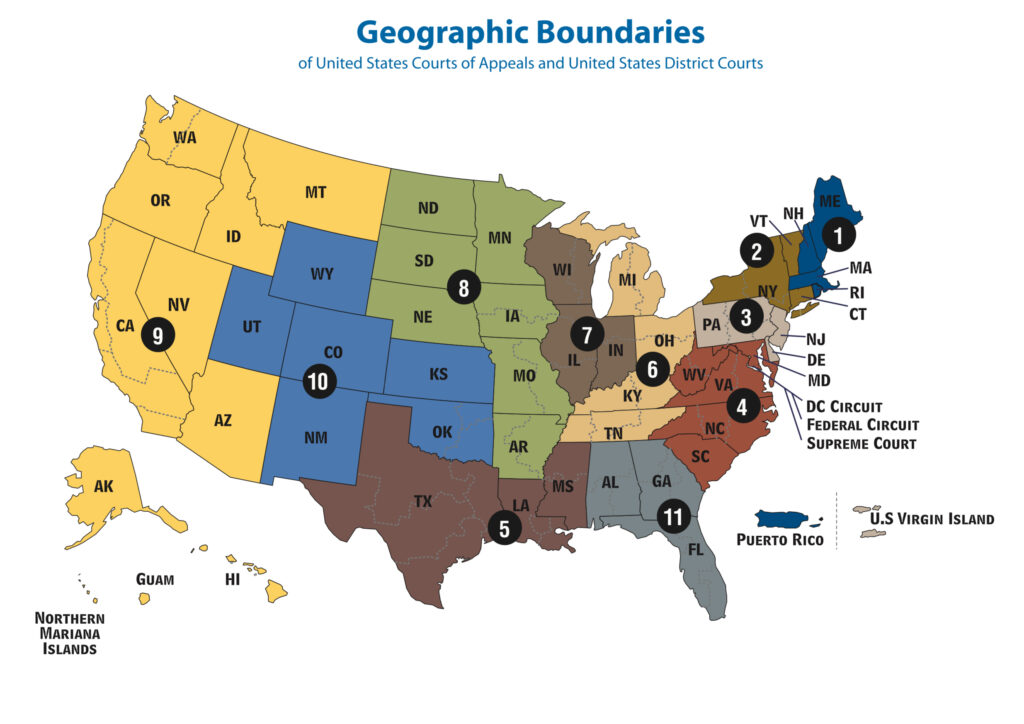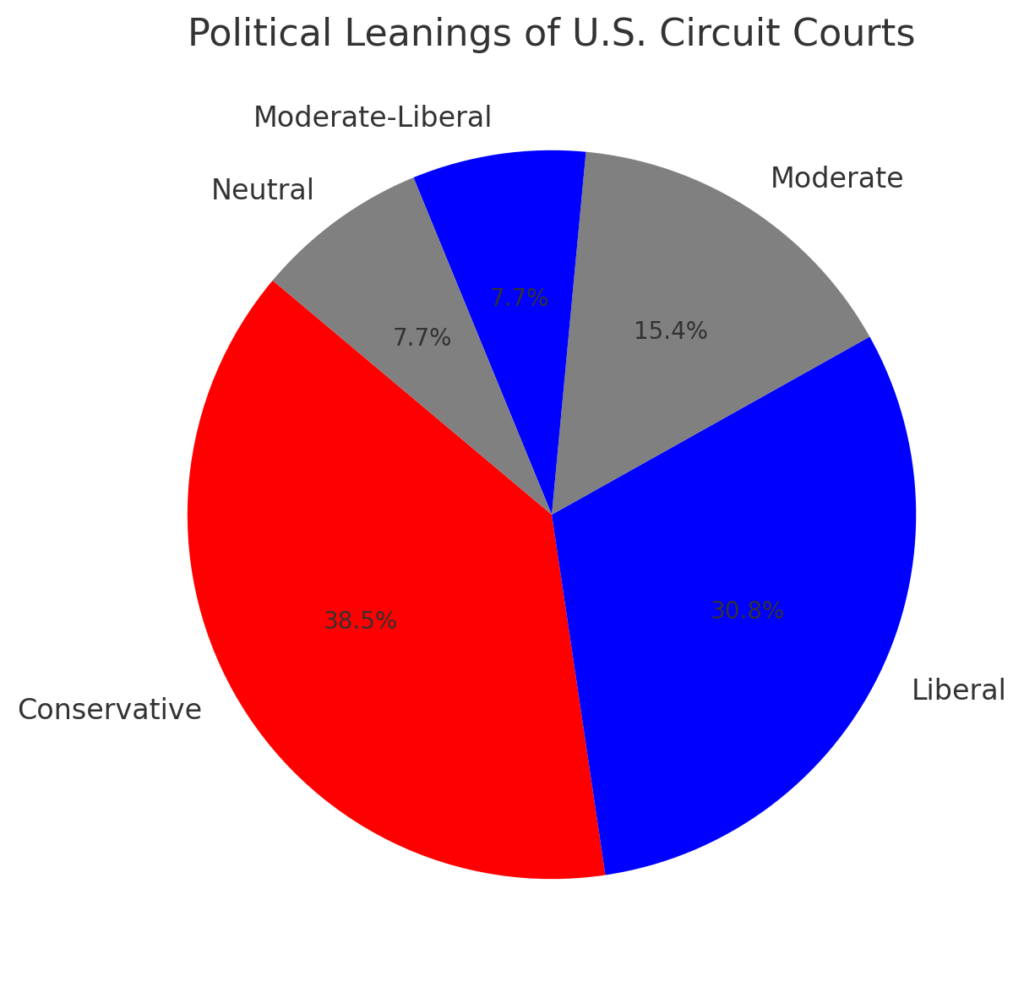Circuit courts, also known as U.S. Courts of Appeals, are the intermediate appellate courts in the federal judicial system. They review decisions from lower district courts, and their rulings often set important legal precedents. There are 13 circuit courts, each covering different regions of the U.S.

The composition of circuit courts matters because the political leanings of the judges (liberal, conservative, or moderate) influence decisions on key business regulations, labor laws, intellectual property, environmental policies, and civil rights. These rulings can shape the legal environment for founders, business leaders, and change agents, affecting how they innovate, operate, and comply with laws.
The circuit courts composition rule on matters crucial for founders, people-centered transformation agents, and organization leaders because these courts often have the final say in key legal decisions that can impact organization operations, policy, and innovation. Here are several reasons why the composition of these courts matters:
- Regulation and Compliance: Circuit courts handle many cases involving business regulations, labor laws, intellectual property rights, antitrust issues, and environmental protections. Decisions can affect how businesses must operate, whether by enforcing stricter regulations or by loosening constraints. Conservative courts tend to favor deregulation and business-friendly policies, while liberal courts may favor stronger protections for workers, consumers, and the environment.
- Innovation and Intellectual Property: For technology companies and innovators, the rulings of circuit courts, especially the Federal Circuit, which handles patent cases, can influence the landscape of intellectual property rights. Whether the courts take a more protectionist or lenient stance on patents can shape competition and innovation strategies.
- Labor Laws and Employment Practices: The composition of circuit courts influences rulings on labor laws, such as collective bargaining, minimum wage, and worker protections. Liberal courts are more likely to support workers’ rights and benefits, while conservative courts may rule in favor of employers seeking fewer restrictions on how they manage labor.
- Civil Rights and Workplace Diversity: Business leaders focused on diversity, equity, and inclusion (DEI) should pay attention to the courts’ leanings because decisions on discrimination, workplace equality, and LGBTQ+ protections are often decided at this level. A more conservative court may be less likely to uphold expansive civil rights protections, which can affect workplace policies and culture.
- Antitrust and Competition Law: For large companies or rapidly scaling startups, circuit courts’ interpretations of antitrust laws can have a profound impact on mergers, acquisitions, and competitive practices. Conservative courts tend to favor market freedoms, potentially enabling more consolidation, while liberal courts may emphasize breaking up monopolies and ensuring market competition.
- Environmental and Sustainability Standards: Companies focused on sustainability and environmental transformation may find that circuit courts’ decisions on environmental laws, climate regulations, and sustainability policies directly affect their business practices. A liberal-leaning court may be more receptive to upholding environmental protections, which could align with sustainability goals, while conservative courts might favor deregulation that could benefit businesses in resource-heavy industries.
- Corporate Governance and Shareholder Rights: Circuit courts sometimes rule on corporate governance issues, including shareholder rights, corporate social responsibility, and fiduciary duties. Liberal courts may favor rulings that enforce transparency and accountability to shareholders and other stakeholders, while conservative courts could lean toward protecting the autonomy of corporate executives.
In sum, the circuit courts’ composition affects the legal landscape that businesses operate in, from regulatory compliance to innovation, labor practices, and sustainability efforts. Organization leaders who understand and anticipate how courts may rule on issues important to their companies can better navigate risks, leverage opportunities, and advocate for policies that align with their goals.
A 2024 Breakdown of the Political Leanings of the Circuit Courts Composition
The 13 U.S. Courts of Appeals (also called Circuit Courts) cover different geographic regions of the country, and the political leanings of each circuit can be influenced by the political affiliations of the judges appointed to those courts. Judges are appointed by the President and confirmed by the Senate, so the composition of each court often reflects the prevailing political landscape at the time of those appointments. Here’s a general overview of the political leanings of the 13 circuits:
- First Circuit (Maine, Massachusetts, New Hampshire, Puerto Rico, Rhode Island):
- Leans liberal due to a higher number of judges appointed by Democratic presidents.
- Second Circuit (Connecticut, New York, Vermont):
- Generally leans liberal, largely influenced by New York and the relatively high number of Democratic appointees.
- Third Circuit (Delaware, New Jersey, Pennsylvania, Virgin Islands):
- Considered moderate, with a slight lean liberal, but Pennsylvania’s more conservative areas can influence some decisions.
- Fourth Circuit (Maryland, North Carolina, South Carolina, Virginia, West Virginia):
- Historically conservative, but more recently considered moderate or slightly liberal due to a shift in appointments.
- Fifth Circuit (Louisiana, Mississippi, Texas):
- Strongly conservative, reflecting the political leanings of the southern states it covers.
- Sixth Circuit (Kentucky, Michigan, Ohio, Tennessee):
- Leans conservative, though Michigan and Ohio can occasionally influence more moderate rulings.
- Seventh Circuit (Illinois, Indiana, Wisconsin):
- Mixed, but typically moderate. Illinois’ liberal influence is balanced by more conservative appointees from Indiana and Wisconsin.
- Eighth Circuit (Arkansas, Iowa, Minnesota, Missouri, Nebraska, North Dakota, South Dakota):
- Strongly conservative, especially reflecting the more conservative nature of the states it covers.
- Ninth Circuit (Alaska, Arizona, California, Hawaii, Idaho, Montana, Nevada, Oregon, Washington, Guam, Northern Mariana Islands):
- Traditionally leans liberal, driven by California and other west coast states, but has become more balanced in recent years with new conservative appointments.
- Tenth Circuit (Colorado, Kansas, New Mexico, Oklahoma, Utah, Wyoming):
- Leans conservative, reflecting the more conservative states in this region.
- Eleventh Circuit (Alabama, Florida, Georgia):
- Strongly conservative, particularly reflecting the political leanings of the southern states it covers.
- D.C. Circuit (District of Columbia):
- Generally leans liberal, as it handles many cases involving federal government agencies, and its judges tend to be more liberal.
- Federal Circuit (nationwide jurisdiction over certain types of cases, such as patents):
- Doesn’t lean distinctly in either direction as it focuses on specialized areas like patents and claims against the U.S. government.
These political leanings can shift over time as new judges are appointed and the composition of each circuit changes, but this provides a general sense of their current orientations.

Leave a Reply